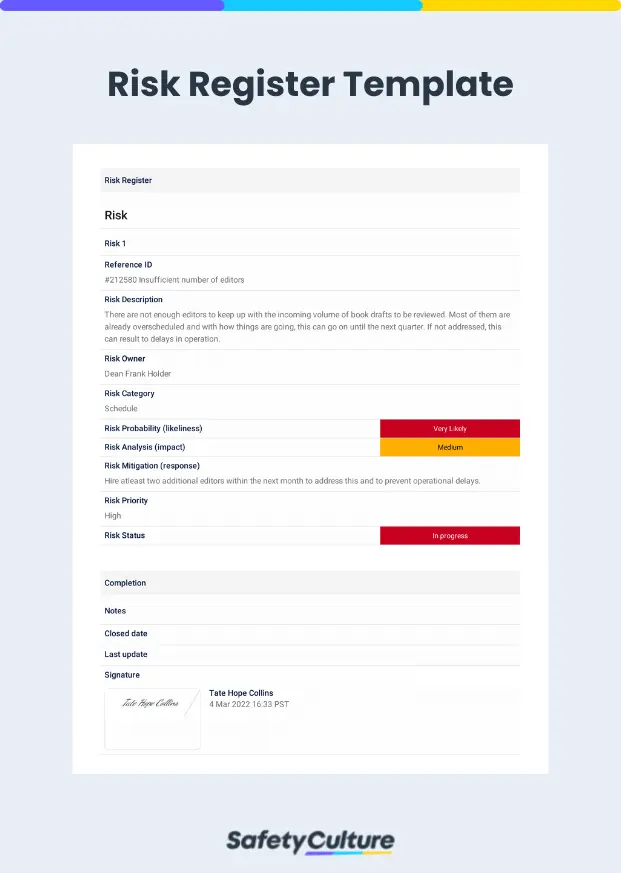What is a Risk Register Template?
A risk register is a compilation of potential risks identified before, during, and after starting a new project. This tool, otherwise known as a risk register template, is used by risk managers and project managers to list and recognize emerging issues, manage risks, and implement solutions to mitigate possible setbacks during projects.
The general goal of a risk register is to record, analyze, and reduce risks by effectively tracking and monitoring them. It is also a document that serves as a database of all the risks identified in a project and ensures accessibility by putting them in one safe place.
As part of successful risk management and project management, this process is performed to proactively identify potential risks and mitigate them before they occur, establish contingency plans if they do happen, and determine the best course of action in addressing them.
Risk Register vs Risk Management
Risk register is part of risk management and includes a list of risks, their descriptions, analysis, and plans for mitigation. Aside from risk register, risk management also includes risk assessment, risk reporting, and risk governance. Another difference between risk register and risk management is that the former specifically focuses on the recording of the risks identified and the level of impact they may have, while the latter discusses the whole plan for managing risks from start to finish.
Why is it Important?
Using a risk register affects the outcome of the risk management process by highlighting crucial risks and specifically including mitigating actions to tackle those risks. Additionally, it helps recognize possible issues that may reappear in the future or in other projects. A risk register also offers the following benefits:
- Proactively spot possible risks faced by the project or company, understand their nature, and emphasize their scope.
- Identify the impact, likeliness, and severity of the mentioned risks and how they would affect your project.
- Recognize the ability to control and reduce risks.
- Create mitigating and contingency actions and plans to lessen risks.
- Track and monitor the status of risks and highlight those that should be prioritized.
- Ease the reviewing process by including important details such as who is responsible for risk monitoring, otherwise known as risk ownership.
- Help prevent project delays and lower the probability of operational setbacks.
What to Include?
Risk registers and their elements vary depending on the industry and the risks associated with a specific project. The following components, however, are the items commonly included in creating a risk register:
Risk ID
The risk ID is the name or number associated with the specific risk and is usually placed at the start of each risk register entry. Ensure that the risk ID is easily identifiable to help with the tracking process and so that team members can quickly find the identified risks.
Risk Description
The risk description is a short but accurate explanation of the scope of the risk and why it’s a potential issue. It should offer a high-level overview and describe the key points of the risk.
Risk Category
Various factors can impact a project, such as budget, schedule, technology, and other external elements. The specifications of the project should also be taken into account and further evaluation may be needed to identify each unique risk category.
Risk Likelihood
As the name suggests, risk likelihood is the probability of the risk occurring and typically uses a variation of not likely, likely, and very likely. It helps in identifying which risks should be addressed and prioritized based on their likelihood.
Risk Analysis
Risk analysis is the evaluation of the potential impact and severity of the risk on the project or the company. While the exact risk analysis method is different for each project or organization, the result (known as risk severity) is commonly categorized as either of the following: very low, low, medium, high, or very high.
Risk Mitigation
One of the most important elements of the risk register, risk mitigation is sometimes referred to as risk response plan or mitigation action. This element identifies possible mitigation plans to help tackle the risk, prevent it from happening, or lessen the impact it may have. The plan should be thorough and include a step-by-step solution on how to minimize the risk, identify the desired outcome, and describe how it will affect the impact and likelihood of the risk.
Risk Priority
Risk priority is determined by assigning a value to each risk or establishing it based on the combined elements of risk likelihood (probability) and risk analysis (potential impact). The higher the probability and potential impact, the more that a risk should be prioritized.
Risk Ownership
Risk ownership identifies the team member who is responsible for the specific risk. This ensures that all of the identified risks will be monitored and supervised accordingly.
Risk Status
Risk status helps communicate if the risk was successfully mitigated or is currently being addressed. Projects usually use the following status options: open, in progress, or closed.
Other elements that are sometimes included in the risk register are the closed date or the specific date that the risk was closed and the last update, which identifies the date when the entry was last updated and is useful in ensuring that mitigating plans are continuously executed.
How to Use a Risk Register: A Step-by-Step Guide
Once you’ve identified the elements to include, you can proceed to the creation of the actual risk register. Below is a step-by-step guide on how to determine risks and analyze them:
Step 1: Identify potential risks
The first step is to identify and record all the potential risks that could derail or put a strain on your project. Some risks may not be apparent at the beginning, but recognizing and listing out as many risks as possible can help in proactively addressing them. While the number of risks may grow as the project progresses, it will also be advantageous to mitigate them as early as possible.
Step 2: Analyze, prioritize, and assign
This step will help identify which of the listed risks should be prioritized based on the severity, impact, likelihood, and other categories that could potentially affect the project. The result of this step will vary depending on the factors recognized, value associated with each category, as well as their level of importance to the project.
Note that, since the analysis differs per project, determining which method would work best and would give an accurate result is vital in successfully mitigating the risks.
It may also be helpful for you to start assigning risks to team members who will be the risk owners (i.e., they will be responsible for supervising a specific risk).
Step 3: Develop mitigating plans
In the third step, a response plan is developed for each listed risk. The response plan explains in detail how to lessen the chance of the risk occurring or how to minimize its impact on the project. A fully-developed response plan uses one of the four types of risk mitigation strategies:
Risk Acceptance
Risk acceptance is used when a risk is obviously unavoidable and it would be more complicated to try to prevent it. Companies will accept the risk as long as it has a lower probability and would not really be detrimental to the development of the project.
Risk Avoidance
Risk avoidance is the action that prevents any exposure to the specific risk. It should be noted that, unlike risk acceptance, this risk mitigation response usually has a high cost associated with it, as it cuts off or alters specific actions or tasks altogether.
Risk Limitation
Risk limitation aims to find other strategies to mitigate the risk if it can’t be completely avoided. Controlling these risks typically involves budget modification, changes in scheduling, or utilizing secondary backups for items identified to be at risk, and implementing the changes without causing too much disruption.
Risk Transference
Companies use risk transference when the risk identified is not one of their distinctive competencies and is best managed by third-parties who are experts in that specific task. This lowers the risk of misusing resources and allows the company to focus on tasks that are more in their area of expertise.
Step 4: Track, adjust, and update
In the final step, you’ll need to monitor the risks throughout the course of the project. It is best to update the risk register after every change so that it would remain accurate and be easier to track.
This could also be a great opportunity to identify which of the risk responses worked best, recognize issues that may reappear in the future, and learn how to mitigate risks and minimize their impact.



